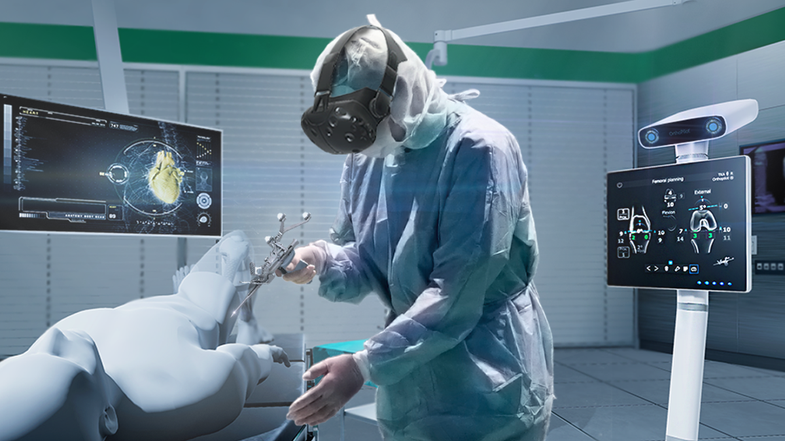
VR in Medical Training
Over the years, the healthcare industry has undergone tremendous evolution, becoming a symbol of technological advancement. In 2020, the global medical technology market was valued at 456.9billionandisprojectedtoreach456.9billionandisprojectedtoreach695.5 billion by 2027. From improving treatments to enhancing patient care and diagnostics, healthcare has embraced digital innovations to elevate its standards. Now, the industry is revolutionizing medical training through Virtual Reality (VR). How does VR promise to boost performance and enhance medical skills? Is VR shaping the future of medical training? Let’s explore in this 3-minute read!
VR in Medical Training: Top Benefits and Use Cases
Over the years, the healthcare industry has undergone tremendous evolution, becoming a symbol of technological advancement. In 2020, the global medical technology market was valued at 456.9billionandisprojectedtoreach456.9billionandisprojectedtoreach695.5 billion by 2027. From improving treatments to enhancing patient care and diagnostics, healthcare has embraced digital innovations to elevate its standards. Now, the industry is revolutionizing medical training through Virtual Reality (VR). How does VR promise to boost performance and enhance medical skills? Is VR shaping the future of medical training? Let’s explore in this 3-minute read!
What Are the Common Challenges in Medical Training?
Medical training is critical and comes with challenges that extend beyond traditional classrooms. The sheer volume of healthcare professionals, the need to grasp complex knowledge quickly, and logistical hurdles all impact the quality and effectiveness of future healthcare. Here are the top challenges in medical training that need urgent attention:
Balancing Quality with Quantity
Reputable healthcare organizations strive to provide regular and effective training for their professionals. However, with large numbers of learners, it becomes difficult to deliver personalized experiences. Limited equipment and resources further complicate the process, potentially leading to underskilled professionals.Logistical Constraints
Coordinating healthcare facilities, scheduling lessons, and preparing interactive training sessions are logistical challenges that hinder the scalability of medical training programs.Adapting to Technological Advancements
The rapid pace of technological innovation in healthcare requires constant updates to training programs. While new technologies offer significant benefits, their implementation can be complex and resource-intensive.Forward-Thinking Strategies
Grasping complex medical concepts in less time demands innovative strategies and curriculum models. Institutions must adapt to the evolving healthcare landscape and cater to the needs of the next generation of learners, who seek dynamic and immersive experiences.
How Does VR Transform Traditional Medical Training?
VR is revolutionizing medical training by replacing traditional methods with immersive, realistic simulations. These simulations allow learners to practice and perfect medical procedures in a safe environment, building muscle memory and confidence. Here’s how VR is advancing medical training:
Simulation of Medical Procedures
VR enables professionals to practice complex procedures in a risk-free virtual environment. High-fidelity simulations replicate real-life scenarios, allowing learners to refine their skills without endangering patients.Enhanced Visualization
With VR, students can explore 3D anatomical structures and medical concepts from multiple angles, enhancing their understanding and retention of complex information.Individualized Learning and Collaboration
VR allows for remote participation, enabling learners from different locations to join the same virtual space. Instructors can supervise in real-time, fostering teamwork and collective learning.Cost-Effective Training
VR reduces the need for expensive equipment like high-fidelity mannequins. It also eliminates travel and accommodation costs, making training more accessible.Emotional and Psychological Training
VR creates high-stress scenarios, helping learners practice under pressure and manage their emotions effectively.Improved Decision-Making
VR scenarios present ethical dilemmas, allowing trainees to explore different outcomes and sharpen their critical thinking and decision-making skills.
What Are the Benefits of VR in Medical Training?
Reduced Training Costs
VR eliminates the need for costly equipment and facilities, making training more affordable without compromising quality.Increased Training Efficiency
Learners can practice at their own pace, repeat simulations, and refine their skills, leading to better retention and confidence.Enhanced Learning Experience
VR’s immersive nature engages multiple senses, bridging the gap between theory and practice and improving knowledge retention.Support for Medical Research
VR enables researchers to simulate diseases, treatments, and clinical trials, accelerating discoveries without risking patient safety.Easy Setup and Scalability
VR systems can be set up quickly in small spaces, allowing institutions to scale their training programs efficiently.
Use Cases of VR in Medical Training
VR Surgical Training
VR simulations help surgeons practice complex procedures, develop motor skills, and receive real-time feedback from instructors.Nursing Training at Johns Hopkins
Johns Hopkins School of Nursing uses VR to train professionals in areas like resuscitation and post-surgical management.Real-Time Feedback at the University of Northampton
The University of Northampton uses VR hardware and large screens to simulate hospital wards, enabling group learning and real-time feedback.Mobile VR Trolleys at the University of Oxford
The University of Oxford uses mobile VR trolleys to transport equipment, facilitating peer learning and flexible training.

How Will VR Revolutionize Healthcare Training?
VR is set to transform healthcare training by providing realistic, risk-free simulations that enhance learning outcomes. Studies show that VR training improves educational outcomes by 74% and boosts performance by 230% compared to traditional methods. By reducing costs, improving accessibility, and supporting research, VR is poised to revolutionize the healthcare industry.
How Can Organizations Implement VR in Medical Training?
Analyze Training Needs
Identify specific skills or procedures that would benefit most from VR simulations.Choose the Right VR Platform
Select a platform that aligns with your organization’s goals and integrates seamlessly with existing systems.Develop High-Quality Content
Collaborate with experts to create accurate, engaging, and interactive VR content.Ensure Accessibility
Make VR training accessible to all learners, including those with disabilities or diverse learning needs.Monitor Performance
Use data analytics to track progress and refine training programs.Stay Updated
Keep up with technological advancements to ensure your VR training remains relevant and effective.
Source: Fingent

Manshour Fanavari Arian
Science and Technology Park Office: Mashhad, 12th kilometer of the Asian Highway, Khorasan Science and Technology Park, Technology and Knowledge-Based Institutions Building